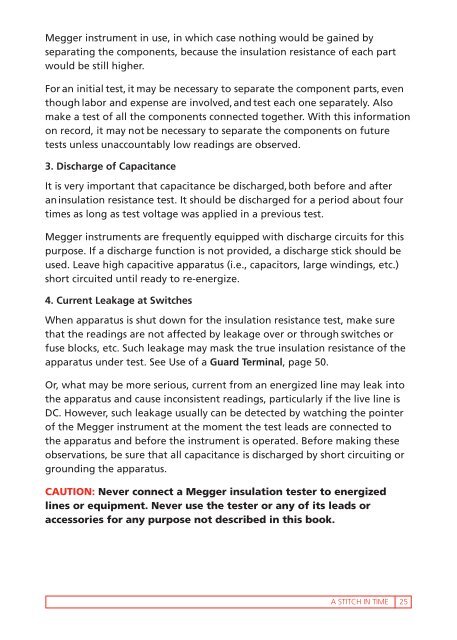“A Stitch in Time...”
Create successful ePaper yourself
Turn your PDF publications into a flip-book with our unique Google optimized e-Paper software.
Megger <strong>in</strong>strument <strong>in</strong> use, <strong>in</strong> which case noth<strong>in</strong>g would be ga<strong>in</strong>ed by<br />
separat<strong>in</strong>g the components, because the <strong>in</strong>sulation resistance of each part<br />
would be still higher.<br />
For an <strong>in</strong>itial test, it may be necessary to separate the component parts, even<br />
though labor and expense are <strong>in</strong>volved, and test each one separately. Also<br />
make a test of all the components connected together. With this <strong>in</strong>formation<br />
on record, it may not be necessary to separate the components on future<br />
tests unless unaccountably low read<strong>in</strong>gs are observed.<br />
3. Discharge of Capacitance<br />
It is very important that capacitance be discharged, both before and after<br />
an <strong>in</strong>sulation resistance test. It should be discharged for a period about four<br />
times as long as test voltage was applied <strong>in</strong> a previous test.<br />
Megger <strong>in</strong>struments are frequently equipped with discharge circuits for this<br />
purpose. If a discharge function is not provided, a discharge stick should be<br />
used. Leave high capacitive apparatus (i.e., capacitors, large w<strong>in</strong>d<strong>in</strong>gs, etc.)<br />
short circuited until ready to re-energize.<br />
4. Current Leakage at Switches<br />
When apparatus is shut down for the <strong>in</strong>sulation resistance test, make sure<br />
that the read<strong>in</strong>gs are not affected by leakage over or through switches or<br />
fuse blocks, etc. Such leakage may mask the true <strong>in</strong>sulation resistance of the<br />
apparatus under test. See Use of a Guard Term<strong>in</strong>al, page 50.<br />
Or, what may be more serious, current from an energized l<strong>in</strong>e may leak <strong>in</strong>to<br />
the apparatus and cause <strong>in</strong>consistent read<strong>in</strong>gs, particularly if the live l<strong>in</strong>e is<br />
DC. However, such leakage usually can be detected by watch<strong>in</strong>g the po<strong>in</strong>ter<br />
of the Megger <strong>in</strong>strument at the moment the test leads are connected to<br />
the apparatus and before the <strong>in</strong>strument is operated. Before mak<strong>in</strong>g these<br />
observations, be sure that all capacitance is discharged by short circuit<strong>in</strong>g or<br />
ground<strong>in</strong>g the apparatus.<br />
CAUTION: Never connect a Megger <strong>in</strong>sulation tester to energized<br />
l<strong>in</strong>es or equipment. Never use the tester or any of its leads or<br />
accessories for any purpose not described <strong>in</strong> this book.<br />
A STITCH IN TIME 25



